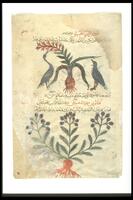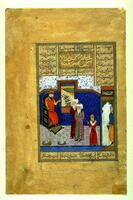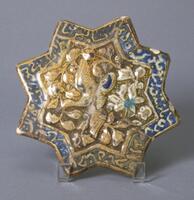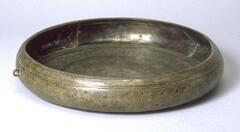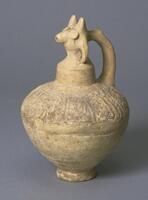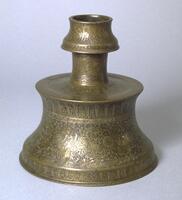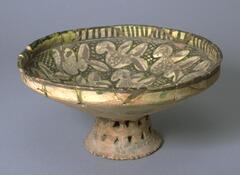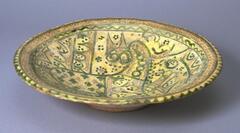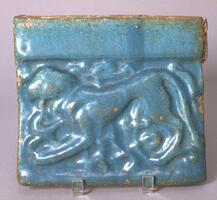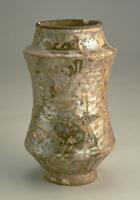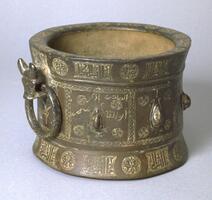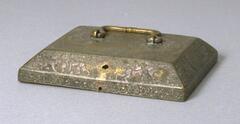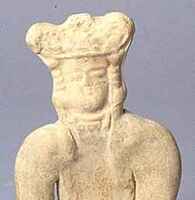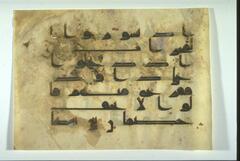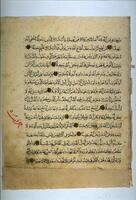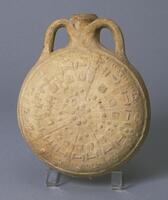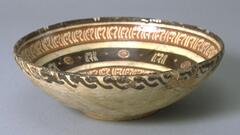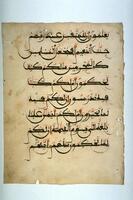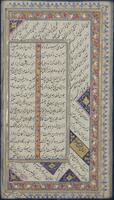54 Items in this Learning Collection
Collection Object
Collection Object
Collection Object
Collection Object
Collection Object
Collection Object
Collection Object
Collection Object
Collection Object
Collection Object
Collection Object
Collection Object
Collection Object
Collection Object
Collection Object
Collection Object
Collection Object
Collection Object
Collection Object
Collection Object
Collection Object
Collection Object
Collection Object
Collection Object
Collection Object
Collection Object
Collection Object
Collection Object
Collection Object
Collection Object
Collection Object
Collection Object
Collection Object
Collection Object
Collection Object
Collection Object
Collection Object
Collection Object
Collection Object
Collection Object
Collection Object
Collection Object
Collection Object
Collection Object
Collection Object
Collection Object
Collection Object
Collection Object
Collection Object
Collection Object
Copyright
All Rights Reserved
()
The Birth of Rustam, from the Shahnama of Firdausi
Accession Number
1963/1.43
Title
The Birth of Rustam, from the Shahnama of Firdausi
Artist(s)
Iranian
Artist Nationality
Iranian
Object Creation Date
circa 1460
Medium & Support
ink, opaque watercolor, and gold leaf on paper
Dimensions
10 7/16 in. x 7 3/16 in. ( 26.5 cm x 18.2 cm )
Credit Line
Museum Purchase
Label copy
Rustam is one of the most beloved figures in the Shahnama. Like his grandfather Sam and father Zal before him, he embodies superhuman strength, courage, and endurance, as well as complete loyalty to the shah.
Rustam’s first appearance in the tale is at the moment of his birth, by Caesarian section. The artist unflinchingly depicts the operation, with Rustam half-emerged from his mother Rudaba’s side. The accompanying text reads:
“Why hast thou grown so wan?”
Rudaba answered:
“By night and day I cry for help. I lie
Sleepless and withered like a living corpse.
My time hath come but not deliverance.” …
There came an archimage,* one deft of hand,
Who made the moon-faced dame bemused with wine,
Then pierced her side while she was all unconscious,
And having turned the infant’s head aright
Delivered her uninjured. None had seen
A thing so strange. The babe was like a lion,
A hero tall and fair to look upon.
A day and night the mother lay asleep,
Bemused, unconscious. They the while sewed up
The wound and eased the anguish with the dressing. … Then they brought the babe
To her, extolling him as heavenly.
Warner, I, 320–22
* archimage: a great magi, i.e. a Zoroastrian priest, magician, or physician
———
Maribeth Graybill, Senior Curator of Asian Art
Exhibited in "A Medieval Masterpiece from Baghdad: the Ann Arbor Shahnama"
August 14 through December 19, 2004
Subject matter
The Birth of Rustam
"Why hast thou grown so wan?"
Rudaba answered:
"By night and day I cry for help. I lie
Sleepless and withered like a living corpse.
My time hath come but not deliverance."
There came an archimage, one deft of hand,
Who made the moon-faced damee bemused with wine,
Then pierced her side while she was all unconsious,
And having turned the infant's head aright
Delivered her uninjured. None had seen
A thing so strange. The babe was like a lion,
A hero tall and fair to look upon.
A day and night the mother lay asleep,
Bemused, unconscious. They the while sewed up
The wound and eased the anguish with the dressing.
Then they brought the babe
To her, extolling him as heavenly.
Physical Description
This painted miniature Shahnama page was made by the Shiraz and Timurid schools, ca. 1460 in Baghdad, Iraq. The painting is done in ink, opaque watercolor and gold leaf on paper. The scene depicts the Birth of Rustam from the Shahnama, the Persian book of kings.
Primary Object Classification
Painting
Collection Area
Western
Rights
If you are interested in using an image for a publication, please visit http://umma.umich.edu/request-image for more information and to fill out the online Image Rights and Reproductions Request Form. Keywords
Iranian Islamic painting styles after the Mongols
Iranian Islamic styles after the Mongols
Persian-Farsi (language)
Shahnama
Timurid
Timurid painting styles
gold leaf
gouache (paint)
man
miniatures (paintings)
shahs
watercolor painting (technique)
1963/1.43
Title
The Birth of Rustam, from the Shahnama of Firdausi
Artist(s)
Iranian
Artist Nationality
Iranian
Object Creation Date
circa 1460
Medium & Support
ink, opaque watercolor, and gold leaf on paper
Dimensions
10 7/16 in. x 7 3/16 in. ( 26.5 cm x 18.2 cm )
Credit Line
Museum Purchase
Label copy
Rustam is one of the most beloved figures in the Shahnama. Like his grandfather Sam and father Zal before him, he embodies superhuman strength, courage, and endurance, as well as complete loyalty to the shah.
Rustam’s first appearance in the tale is at the moment of his birth, by Caesarian section. The artist unflinchingly depicts the operation, with Rustam half-emerged from his mother Rudaba’s side. The accompanying text reads:
“Why hast thou grown so wan?”
Rudaba answered:
“By night and day I cry for help. I lie
Sleepless and withered like a living corpse.
My time hath come but not deliverance.” …
There came an archimage,* one deft of hand,
Who made the moon-faced dame bemused with wine,
Then pierced her side while she was all unconscious,
And having turned the infant’s head aright
Delivered her uninjured. None had seen
A thing so strange. The babe was like a lion,
A hero tall and fair to look upon.
A day and night the mother lay asleep,
Bemused, unconscious. They the while sewed up
The wound and eased the anguish with the dressing. … Then they brought the babe
To her, extolling him as heavenly.
Warner, I, 320–22
* archimage: a great magi, i.e. a Zoroastrian priest, magician, or physician
———
Maribeth Graybill, Senior Curator of Asian Art
Exhibited in "A Medieval Masterpiece from Baghdad: the Ann Arbor Shahnama"
August 14 through December 19, 2004
Subject matter
The Birth of Rustam
"Why hast thou grown so wan?"
Rudaba answered:
"By night and day I cry for help. I lie
Sleepless and withered like a living corpse.
My time hath come but not deliverance."
There came an archimage, one deft of hand,
Who made the moon-faced damee bemused with wine,
Then pierced her side while she was all unconsious,
And having turned the infant's head aright
Delivered her uninjured. None had seen
A thing so strange. The babe was like a lion,
A hero tall and fair to look upon.
A day and night the mother lay asleep,
Bemused, unconscious. They the while sewed up
The wound and eased the anguish with the dressing.
Then they brought the babe
To her, extolling him as heavenly.
Physical Description
This painted miniature Shahnama page was made by the Shiraz and Timurid schools, ca. 1460 in Baghdad, Iraq. The painting is done in ink, opaque watercolor and gold leaf on paper. The scene depicts the Birth of Rustam from the Shahnama, the Persian book of kings.
Primary Object Classification
Painting
Collection Area
Western
Rights
If you are interested in using an image for a publication, please visit http://umma.umich.edu/request-image for more information and to fill out the online Image Rights and Reproductions Request Form. Keywords
Iranian Islamic painting styles after the Mongols
Iranian Islamic styles after the Mongols
Persian-Farsi (language)
Shahnama
Timurid
Timurid painting styles
gold leaf
gouache (paint)
man
miniatures (paintings)
shahs
watercolor painting (technique)

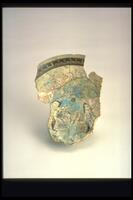


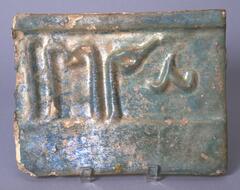
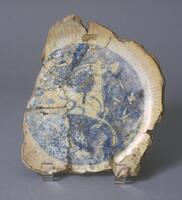
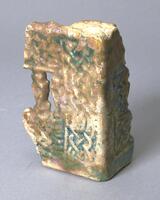
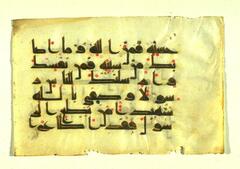
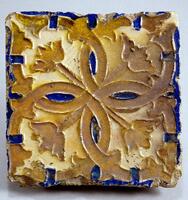
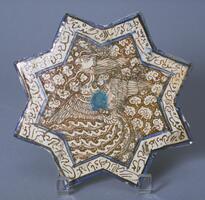

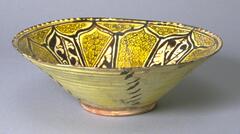
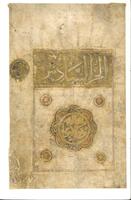
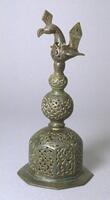
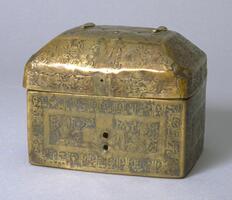



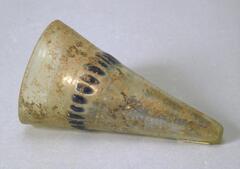
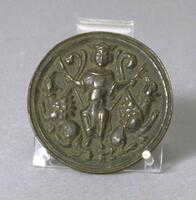

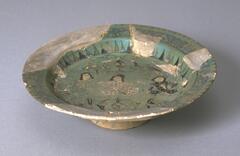

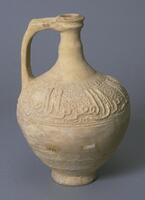

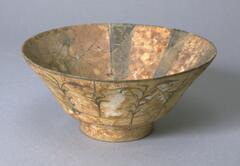
!["Object EFS-105 is a 14th century Mongolian-influenced Sultanabad work. The body of the object is a pinkish-tan while the outside is covered with painted blue tinge. The central motif is a spotted lion [leopard]. Stylized birds circle the inside of the object against a naturalistically conceived floral area. The object has been re-pieced extensively. <br /><br />
This object bears the characteristic hemispherical shape of Sultanabad work, and its rendering of the birds and floral motif indicate the Chinese influence of the 14th century. The animal and birds are outlined in black. It follows the general color scheme and motifs of the Sultanabad wares of the 14th century. <br /><br />
The object is 4 inches high and has a diameter of 8 inches. The lion [leopard] is rendered with the Iranian sensitivity and perceptiveness. This object was probably highlighted with white slip." "Object EFS-105 is a 14th century Mongolian-influenced Sultanabad work. The body of the object is a pinkish-tan while the outside is covered with painted blue tinge. The central motif is a spotted lion [leopard]. Stylized birds circle the inside of the object against a naturalistically conceived floral area. The object has been re-pieced extensively. <br /><br />
This object bears the characteristic hemispherical shape of Sultanabad work, and its rendering of the birds and floral motif indicate the Chinese influence of the 14th century. The animal and birds are outlined in black. It follows the general color scheme and motifs of the Sultanabad wares of the 14th century. <br /><br />
The object is 4 inches high and has a diameter of 8 inches. The lion [leopard] is rendered with the Iranian sensitivity and perceptiveness. This object was probably highlighted with white slip."](/media/W1siZiIsIjIwMjIvMDUvMjUvN3planB1NG5tbl9kZWZhdWx0LmpwZyJdLFsicCIsInRodW1iIiwiMjQweDIwMCJdXQ?sha=215dcc1d938a8d43)
